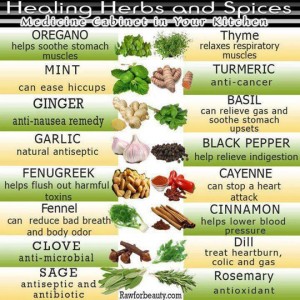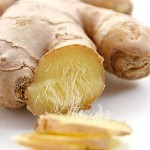Author Archives: goddess
Make your own Indian spiced garam masala
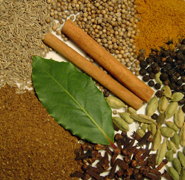 Garam masala from the Hindi: garam (“hot”) and masala (spices) is a blend of ground spices common in North Indian and other South Asian cuisines. You can buy a spice mixture called Garam Masala, or create your own using these seasonings:
Garam masala from the Hindi: garam (“hot”) and masala (spices) is a blend of ground spices common in North Indian and other South Asian cuisines. You can buy a spice mixture called Garam Masala, or create your own using these seasonings:
1/2 teaspoon ground cumin
1/2 teaspoon paprika
1/4 teaspoon ground cinnamon
1/4 teaspoon cayenne
1/4 teaspoon cracked dried bay leaves
1/8 teaspoon ground cloves
Also pictured is coriander seed, and allspice.
RELATED: Here’s my own Andrea’s Personal Masala
Healing and Medicinal Properties of Cooking Spices
Lowfat Eggs Florentine with Baby Spinach and Feta Cheese
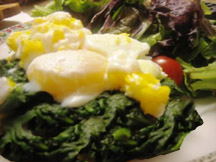 This morning’s breakfast was my easy version of a low fat Eggs Florentine. I like high flavor in my veggies, so I often saute 1/2 tsp or more each fresh ground coriander, cumin, fennel and about a dozen mustard seeds for a few minutes in a little olive oil before every dish I cook. I added half a chopped onion and let it carmelize in the ground spices. I threw in a giant handful of fresh baby spinach and covered the pan. It will wilt down like 80% as it cooks. After about a minute when the spinach begins to wilt, lower the heat. Break an egg or two atop the spinach, cover again and cook maybe 2-3 minutes until egg whites are set and yolks are the way you like them. I like a warm but wet yolk. This recipe is low fat because I top it with a little low fat feta cheese instead of a hollandaise sauce. You can also serve it atop hearty slices of sourdough toast or English muffins. Serves one.
This morning’s breakfast was my easy version of a low fat Eggs Florentine. I like high flavor in my veggies, so I often saute 1/2 tsp or more each fresh ground coriander, cumin, fennel and about a dozen mustard seeds for a few minutes in a little olive oil before every dish I cook. I added half a chopped onion and let it carmelize in the ground spices. I threw in a giant handful of fresh baby spinach and covered the pan. It will wilt down like 80% as it cooks. After about a minute when the spinach begins to wilt, lower the heat. Break an egg or two atop the spinach, cover again and cook maybe 2-3 minutes until egg whites are set and yolks are the way you like them. I like a warm but wet yolk. This recipe is low fat because I top it with a little low fat feta cheese instead of a hollandaise sauce. You can also serve it atop hearty slices of sourdough toast or English muffins. Serves one.
Indian spiced sweet potato, kale, yellow squash hash
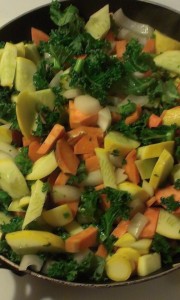 This morning’s breakfast was a sweet potato, kale, yellow squash hash. First i grind a half teaspoon of cumin, coriander and fennel seeds along with about a dozen mustard seeds, and I add them to some heated olive oil to sauté for a minute or two. Then add one small sliced onion and the sweet potato and cook until a little crisp. Remove from the pan to keep crisp if you like, to add upon serving. Add chopped kale and the squash and let the kale cook using the water from the squash, for about 10 minutes. You might add a little water or broth to keep it steaming. You can also use fresh spinach instead of kale, or cook it in olive oil if you are not keeping it low fat.
This morning’s breakfast was a sweet potato, kale, yellow squash hash. First i grind a half teaspoon of cumin, coriander and fennel seeds along with about a dozen mustard seeds, and I add them to some heated olive oil to sauté for a minute or two. Then add one small sliced onion and the sweet potato and cook until a little crisp. Remove from the pan to keep crisp if you like, to add upon serving. Add chopped kale and the squash and let the kale cook using the water from the squash, for about 10 minutes. You might add a little water or broth to keep it steaming. You can also use fresh spinach instead of kale, or cook it in olive oil if you are not keeping it low fat.
What I keep in my pantry
My pantry always includes:
Packaged fat free vegetable broth
Packaged fat free chicken broth
Canned crushed tomatoes
Canned stewed tomatoes
Canned garbanzo beans for hummus Continue reading
No more sweetener for me
Interesting. The last two months I’ve had coffee each morning, sometimes with sugar but as often with Stevia or Sweet & Low, and a splash of 2% milk. The past two months I’ve kept on an extra 8 lbs. Cause + effect = no more sweetner for me.
How to store fresh ginger root
Fresh ginger root has a strong flavor that adds zest to many recipes. Ginger has anti-inflammatory and gastrointestinal health benefits. When you purchase fresh ginger, examine it closely. Fresh ginger has a smooth surface, but will feel firm when you squeeze it slightly. Ginger root has a white flesh and a light brown skin. Fresh ginger needs to be stored properly to prolong its shelf life and to prevent mold from forming. Continue reading
A lowfat yet authentic Greek Salad
This is my favorite Greek salad, and with lowfat feta and being sparing with the oil, I make this a low fat dish.
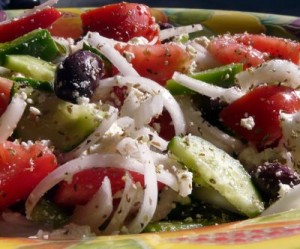 Ingredients:
Ingredients:
1 vine ripened tomato / quartered
1 cucumber / peeled and sliced
1 small red onion / thinly sliced
1 small green pepper / thinly sliced
A few black olives or Greek Calamata olives
Low fat feta cheese
1 tsp oregano
Salt
Extra virgin olive oil
Put the tomato, cucumber, red onion, green pepper, and olives into a big bowl and sprinkle with salt and oregano. I add chopped romaine. Mix it all together then top with a sprinkle of crumbled lowfat feta cheese.
Leave the bowl to stand for 20 minutes. This will allow the salt to soak into the tomatoes and bring out the juice, and will allow the cheese to get to room temperature. Just before serving, drizzle with olive oil and sprinkle more oregano on top. I also squeeze lemon juice into it.
Five delicious salads served at Ossorio’s in Cocoa Village
The fresh salads served at Ossorio Bakery and Cafe in Cocoa Village are delicious. I post them here so I may be reminded of some delicious salad combinations.
Morgan’s
Spring baby greens, smoked bacon, fresh berries, roasted pecans and balsamic vinaigrette. Served with our baguette toast topped with goat and cream cheese spread.
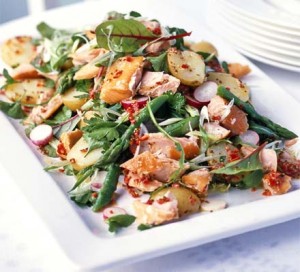 Francoise’s
Francoise’s
Roasted asparagus, baby spring greens, our own salt and brown sugar cured, thinly sliced salmon with lemon vinaigrette served with baguette toast. Continue reading
My homemade Indian Spiced Chicken Curry
My fave spice palette right now is Andrea’s Personal Masala Blend. It’s not hot but it is spicy. Masala is the Indian term for a blend of spices. It can be any simple or complex combination. I grind fresh seeds in a coffee grinder and place in a shaker bottle marked “Andrea’s Spice Mix.” The spices I use have been proven to possess therapeutic and healing properties. Spices and herbs contain antioxidants, minerals and multivitamins. Because spices are nutrient dense, they are thermogenic, which means they naturally increase your metabolism. Centuries old eastern medicine and now recent studies and scientific research both boast the medicinal healing benefits of spices. Discover what your favorite flavors are and create your own signature blend to share with friends. Here’s my latest fave. Andrea’s Personal Masala Blend

